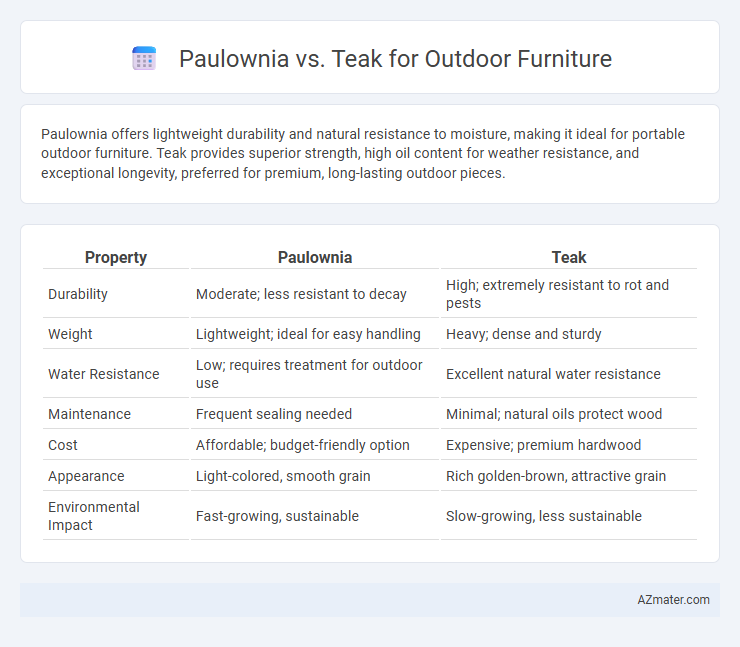Paulownia offers lightweight durability and natural resistance to moisture, making it ideal for portable outdoor furniture. Teak provides superior strength, high oil content for weather resistance, and exceptional longevity, preferred for premium, long-lasting outdoor pieces.
Table of Comparison
| Property | Paulownia | Teak |
|---|---|---|
| Durability | Moderate; less resistant to decay | High; extremely resistant to rot and pests |
| Weight | Lightweight; ideal for easy handling | Heavy; dense and sturdy |
| Water Resistance | Low; requires treatment for outdoor use | Excellent natural water resistance |
| Maintenance | Frequent sealing needed | Minimal; natural oils protect wood |
| Cost | Affordable; budget-friendly option | Expensive; premium hardwood |
| Appearance | Light-colored, smooth grain | Rich golden-brown, attractive grain |
| Environmental Impact | Fast-growing, sustainable | Slow-growing, less sustainable |
Introduction: Paulownia vs Teak for Outdoor Furniture
Paulownia and teak are popular choices for outdoor furniture due to their durability and aesthetic appeal. Paulownia is lightweight, fast-growing, and resistant to warping, making it an eco-friendly option with a smooth, pale finish. Teak, known for its high oil content and dense grain, offers exceptional weather resistance, longevity, and a rich golden-brown hue that enhances outdoor settings.
Wood Characteristics: Texture, Color, and Grain
Paulownia wood features a lightweight texture with a smooth, fine grain, and a pale cream to light brown color that ages to a soft golden hue, making it ideal for lightweight outdoor furniture. Teak wood boasts a dense, oily texture with a straight grain pattern and a rich golden-brown to dark honey color that naturally resists moisture and insects, enhancing its durability in outdoor conditions. The contrast in texture and grain highlights Paulownia's ease of handling versus teak's superior weather resistance and long-lasting aesthetic appeal.
Durability and Weather Resistance
Paulownia wood offers excellent lightweight properties but lower durability and moderate weather resistance, making it less ideal for long-term outdoor furniture exposed to harsh elements. Teak is renowned for superior durability and exceptional natural weather resistance, thanks to its dense grain and high oil content, which protect against rot, insects, and moisture. Choosing teak over paulownia ensures outdoor furniture that maintains structural integrity and aesthetic appeal in varying climates over time.
Weight and Ease of Handling
Paulownia wood is significantly lighter than teak, making it easier to handle and move for outdoor furniture applications. While teak boasts superior durability and natural resistance to weather, its dense weight can pose challenges during installation or rearrangement. Paulownia's lightweight characteristic combined with moderate strength offers a practical option for those prioritizing portability in outdoor settings.
Maintenance Requirements
Paulownia wood demands minimal maintenance due to its natural resistance to moisture and decay, making it ideal for low-upkeep outdoor furniture. Teak requires regular upkeep such as oiling and cleaning to preserve its durability and rich appearance, especially in harsh weather conditions. Both woods offer excellent longevity, but Paulownia's maintenance ease appeals to those seeking hassle-free outdoor furniture.
Sustainability and Environmental Impact
Paulownia wood is highly sustainable due to its rapid growth rate, ability to absorb significant amounts of CO2, and minimal water requirements, making it an eco-friendly choice for outdoor furniture. Teak offers durability and natural resistance to pests and weather but grows much slower and often involves deforestation in tropical forests, raising concerns about environmental impact and sustainability. Choosing Paulownia supports carbon sequestration and sustainable forestry practices more effectively than teak, which requires careful sourcing from certified plantations to minimize ecological damage.
Cost Comparison
Paulownia wood is significantly more affordable than teak, making it a cost-effective option for outdoor furniture without sacrificing durability. Teak's high price is justified by its natural oils and dense grain that resist weathering and insects, leading to lower maintenance costs over time. Choosing paulownia reduces upfront investment, while teak offers long-term value through exceptional longevity and minimal upkeep.
Suitability for Various Outdoor Settings
Paulownia offers lightweight durability and natural resistance to moisture, making it suitable for outdoor furniture in humid or coastal environments where easy handling and quick drying are essential. Teak, known for its dense oil content and exceptional resistance to rot and insects, excels in high-traffic outdoor settings such as patios and gardens, enduring harsh weather conditions with minimal maintenance. Both woods provide unique advantages in outdoor furniture applications, with Paulownia favored for portability and teak preferred for long-term weather resilience.
Lifespan and Long-Term Performance
Paulownia wood offers lightweight and moderate durability with a typical lifespan of 10-15 years in outdoor settings, making it suitable for less exposed furniture. Teak wood excels in long-term performance due to its natural oils and dense grain, providing superior resistance to rot, insects, and weather, often lasting 25-50 years or more with minimal maintenance. The investment in teak furniture ensures extended durability and sustained aesthetic appeal, while Paulownia favors budget-conscious applications with shorter lifespan expectations.
Final Verdict: Which Wood is Better for Outdoor Furniture?
Paulownia offers lightweight durability and rapid growth, making it an eco-friendly choice for outdoor furniture, but its softness makes it less resistant to dents and scratches compared to teak. Teak wood stands out for its natural oils, dense grain, and exceptional weather resistance, ensuring longevity and minimal maintenance in outdoor environments. For outdoor furniture requiring superior durability and resistance to harsh weather conditions, teak is generally the better option despite its higher cost and slower growth rate.

Infographic: Paulownia vs Teak for Outdoor furniture
 azmater.com
azmater.com